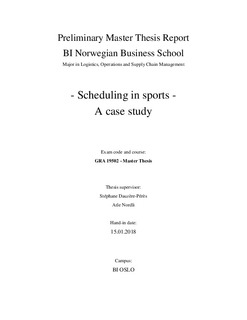| dc.description.abstract | In this thesis, we present models to schedule round-robin tournaments. Based on
attributes of the 2017/2018 schedule for the Norwegian top volleyball league, the
Mizuno League, the models aim to (1) distribute the number of breaks more evenly
among the teams in the league, (2) introduce a maximum number of consecutive
home or away matches, (3) more evenly distribute the number of matches per round
(4) reduce the total number of rounds from 15 to 14 (5) create a fairer and over-all
better schedule and (6) minimize travel distance, and thereby costs.
The thesis describes five models to tackle the aims above:
• Model 1: A linear integer programming model to schedule a single roundrobin.
• Model 2: A linear integer programming model to minimize breaks in a single
round-robin tournament.
• Model 3: A constraint programming model to minimize breaks in a double
round-robin tournament.
• Model 4: A linear integer programming model to minimize travel distance
with predefined timetables in a double round-robin tournament.
• Model 5: A constraint programming model to minimize travel distance in a
double round-robin tournament.
All models attempt to schedule a seasonal tournament based on the constraints and
objective of the top Norwegian volleyball league, The Mizuno League. The Models
are tested and benchmarked on the number of breaks and travel distance from the
schedule of 2017/2018 season of the Mizuno League.
Model 2 to 5 all reduced the number of breaks compared to the Mizuno League.
Model 5, a constraint programming model proved to reduce travel distance by 10% to
29%. Because of tight budgets, the most suitable model to schedule the Mizuno
League is Model 5. Efforts have been taken in section 6 to alter the schedule from
Model 5 to best fit the practical requirements of the Mizuno League.
Finally, we re-solve Model 5 where we change the objective of minimizing travel
distance to minimize travel cost. | nb_NO |

